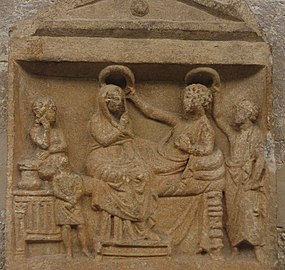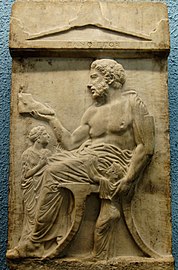
Ancient Greek funeral and burial practices
Ancient Greek funerary practices are attested widely in literature, the archaeological record, and in ancient Greek art. Finds associated with burials are an important source for ancient Greek culture, though Greek funerals are not as well documented as those of the ancient Romans.[1]
Mycenaean Period[edit]
The Mycenaeans practiced a burial of the dead, and did so consistently.[2] The body of the deceased was prepared to lie in state, followed by a procession to the resting place, a single grave or a family tomb. These processions were usually done by family or friends of the deceased. Processions and ritual laments are depicted on burial chests (larnakes) from Tanagra. Grave goods such as jewelry, weapons, and vessels were arranged around the body on the floor of the tomb. Graveside rituals included libations and a meal, since food and broken cups are also found at tombs. A tomb at Marathon contained the remains of horses that may have been sacrificed at the site after drawing the funeral cart there. The Mycenaeans seem to have practiced secondary burial, when the deceased and associated grave goods were rearranged in the tomb to make room for new burials. Until about 1100 BC, group burials in chamber tombs predominated among Bronze Age Greeks.[3]
Mycenaean cemeteries were located near population centers, with single graves for people of modest means and chamber tombs for elite families. The tholos is characteristic of Mycenaean elite tomb construction. The royal burials uncovered by Heinrich Schliemann in 1874 remain the most famous of the Mycenaean tombs. With grave goods indicating they were in use from about 1550 to 1500 BC, these were enclosed by walls almost two and a half centuries later—an indication that these ancestral dead continued to be honored. An exemplary stele depicting a man driving a chariot suggests the esteem in which physical prowess was held in this culture.
Later Greeks thought of the Mycenaean period as an age of heroes, as represented in the Homeric epics. Greek hero cult centered on tombs.







